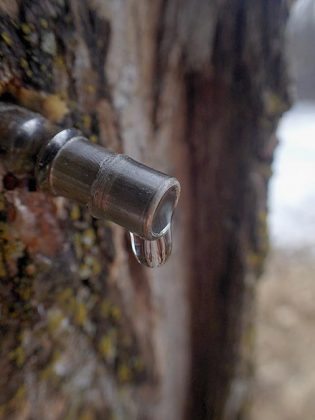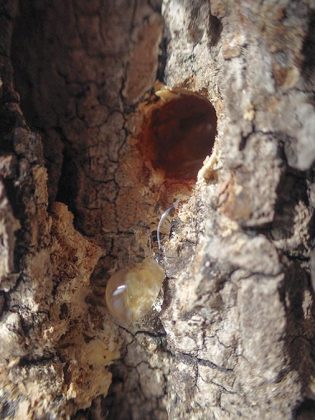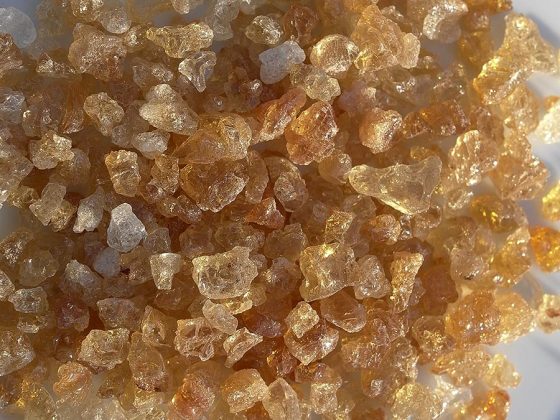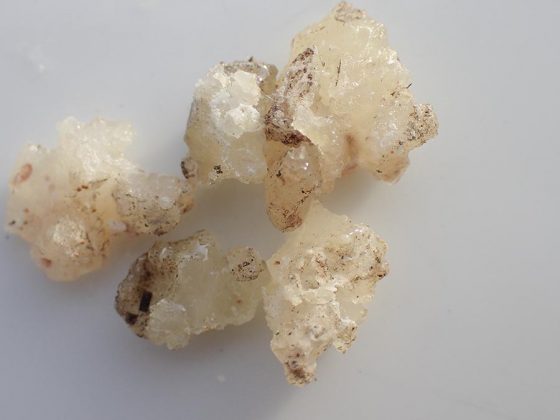Textures and tastes from tree saps and resins are underacknowledged and underutilized in an industry that raves about trees in the context of provenance and type of wood used for all-important barrels. Although, for millennia the fluid that runs through trees has been used in drinks. Getting to know local trees and how they taste isn’t about novel ingredients; it’s about remembering ancient ones.
Being insoluble in water and fragrant, many resins have been used as chewing gum; some of these have transitioned into use in beverage flavor and texture. Appearing in the writings of ancient scholars including Hippocrates, Galen, Discorides and Herodotus, the history of using mastic as a chewing gum, medicinal herb and wine flavoring is at least 2,400 years old. Harvested from Pistacia lentiscus, a relative of pistachio that grows on the Greek island Chios, its trade value was high enough for the penalty of stealing mastic to be execution. Its soft piney aroma is easier to blend with other ingredients than more strident pine notes from conifers. Mastic continues to be a key ingredient in the traditional Greek liqueur mastika. Resins combine well with herbs and citrus in liqueurs, but be wary of resins added to soft fruit; it can result in products that taste medicinal rather than enjoyable.
Biblical ingredients frankincense (Boswellia species) and myrhh (Commiphora species) are resins that occasionally make appearances in gin and vermouth, for example Sacred gin and Myrrha vermouth. Their deep incense aromas add excellent depth to beverages. But supply chains of frankincense and myrrh do not always use sustainable harvesting practices.
In Ancient Greece resin from Aleppo pines (Picea halepensis) was applied to seal amphorae used to store and transport wine. Being accustomed to wine seasoned with pine meant that resin continued to be added to wine when the vessels used to store it changed to barrels. Greece’s national wine, retsina, made with Aleppo pine resin, has evolved over the past few decades from a mass market cheap wine to a category that includes wines praised for their quality. While pine flavors can be strident if used in excess, used sparingly they offer freshness and depth in particular to liqueurs, gins and vermouths. Douglas fir (Pseudotsuga menziesii) is a mild introduction to the pine (Pinaceae) family, as it has citrusy notes.Its sap dries as resin on the surface of Douglas fir trunks if they are cut and also on green cones.
A resin so commonly used that most people have consumed it is gum arabic, which is harvested from acacia trees, predominantly Sudan gum (Senegalia senegal). As well as being an ingredient in sweets, it is used in many soft drinks. With negligible flavor, its key asset is an ability to introduce mouthfeel and weightiness to liquids. Unlike true resins, gum arabic is soluble in water.
Predominantly found in Texas, New Mexico and Arizona but also present in California, Oklahoma, Kansas and Louisiana a cluster of native tree species can also lend naturally mucilaginous properties from their resin to drinks — mesquite (Prosopsis species). While red fortified wines don’t need assistance in creating mouthfeel, mesquite gum can be a useful addition to fortified white wines.
Resins are sap harvested as it has dried on trees. As an ingredient for year-round production, they are conveniently compact for storage and have long shelf life. On the other hand sap, which is liquid and perishable, needs concentration into syrup or reduction to sugar in order to improve its shelf life and reduce its volume for storage.
Sap is collected by tapping trees, and this must be done at the right time. If you drill a hole in a tree at the wrong time sap doesn’t start dripping out. Sap flows out best when on its journey between being sugars and nutrients stored underground in roots and being in branch tips and leaves. In springtime that movement fuels leaves unfurling, in fall it is drawing resources out of leaves before they are dropped and saving them as a cache underground. In spring, if leaf buds are breaking open, sap has already travelled to its destination. Temperatures reaching specific levels of warmth is a trigger for sap rising in some species of trees. In others, springtime growth is prompted by day length. There can be differences of several weeks in when sap is flowing depending on location. It takes a few years to get to know local trees and become adept at anticipating when sap will run. Which can make it worthwhile to work with a local forager who can harvest sap for you or teach you about seasonal rhythms of trees in your area. Additionally for those accustomed to knowing trees by their leaves, identifying deciduous trees in winter when they have no leaves is a skill to learn. Honing in on features like their silhouette, buds, bark texture and shades of brown and gray is a little Zen.
Tapping is mostly depicted as using a spile placed in a drilled hole in order to direct sap into a bucket. At small scale and domestic levels it is still done with low-tech bucket systems. Contemporary commercial sap harvesting more often uses tubing running amongst trees and vacuum to speed harvesting and transport of syrup for large-scale production. Heating to evaporate water out of sap is high in energy consumption. A lot of syrup production now uses reverse osmosis to remove up to 90% of water, with only final stage water reduction over heat.
Most tree tapping for sap in temperate zones takes place in spring. An exception to this is Oriental sweetgum (Liquidambar orientalis), which is harvested in late fall. Native to southwest Turkey and Greece, its sap is used in sweets and as a coffee flavoring. Closely related sweetgum (Liquidambar styraciflua) grows in the USA. As indicated by its name, sweetgum has a history of being chewed as gum. Similar in fragrance to Oriental sweetgum, it may also like gum Arabic, work as an element that adds weightiness to drinks. Although in this case it will be accompanied by light pine aroma.
Sugar maple (Acer saccharum) is the tree most people would name as having edible sap. It is twice as sweet as other trees’ sap, which makes it much quicker to concentrate into syrup or sugar — taking 40 gallons of sap to produce 1 gallon of syrup. Its relatively soft flavor is best deployed in liqueurs, as is black walnut (Juglans nigra) syrup. It takes twice as much effort to make black walnut syrup as maple syrup because the sugar content of black walnut sap is half that of sugar maple, however, this is worthwhile. As you might imagine black walnut syrup taste like walnuts and sugar.
Birch (Betula species) have more fiercely flavored sap that can hold its ground in combination with strong and bitter ingredients or in spirits with high alcohol content like gin and aquavit. Edible birch species native to the USA that can be tapped for sap include yellow birch (Betula alleghaniensis) and paper birch (Betula papyrifera). Their sap also has lower sugar content than sugar maple; it takes 110 gallons of sap to make 1 gallon of syrup. But that birch syrup has a much stronger flavor.
After several years of tree tapping the process remains humbling. Given great bounty of sap dripping into collection buckets, it is hard to comprehend how this is a fraction of the sap coursing through a tree. It is also a little dizzying to imagine how vast the array of roots underground that store sap during winter are. While tree trunks might look still, they are filled with torrents that move seasonally.
Trees can be tapped for sap or have resin collected year after year and continue to thrive and grow. While they can provide abundance seemingly effortlessly, they do need custodianship. Invasive species like tree of heaven (Ailanthus altissima) and kudzu (Pueraria species) can smother native forest trees. Waves of pests and diseases have been moving across American forests, for example hemlock woolly adelgids that attack hemlocks (Tsuga species) and chestnut blight that attack chestnuts (Castanea dentata). Looking after populations of trees can take a variety of forms, from propagating seedlings to reducing invasive species, giving generation of trees that will be harvested from in future years a helping hand. Perhaps tapping trees and harvesting their resin and sap becomes a covenant where these freely given ingredients are received with thanks and encourage us to be custodians of trees.














